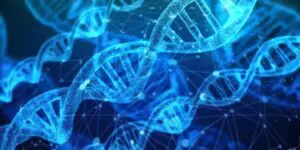“My genes made me do it,” said no one ever when relating how they were drawn into addiction. But that statement isn’t necessarily as far off as you might think. Genes have a vital role in our susceptibility to certain diseases, including addiction. Just how much, though, remains to be seen.

(geralt/Pixabay)
Genetics and Disease
You probably learned in high school biology that your genes determine what you look like and how your body functions. What you may not realize, though, is that genetic research in the last couple of decades has shown how genes can also warn us about the hereditary disease and offer insights into what medications may work better for us.
Your body has trillions of cells, nearly all containing genetic material called DNA. A Gene is a section of DNA that determines what proteins the body produces to activate a specific bodily function. For instance, one well-studied hair color gene is MC1R. It creates a protein that is essential in melanin production and pigmentation. BRCA1 and BRCA2, also known as breast cancer genes, produce proteins aimed at repairing damaged DNA.
Health problems arise because genes can mutate, creating harmful variants that do the opposite of their original function. Genetic testing can tell you if you’re positive for a gene mutation and warn you of your vulnerability to certain diseases. Having a BRCA1 or BRCA2 variant, for example, increases your likelihood of developing breast and other cancers.
Are There Addiction Genes?
The short answer is Yes. Scientists have found many genes that contribute to drug and alcohol addiction, and they could find more in future research. In addition, genetic predisposition accounts for about half of a person’s risk for developing a substance use disorder (SUD). Studies indicate that the other half of addiction risk stems from environmental factors. We’ll talk more about those in a bit.
Genetic addiction data usually comes from two primary sources – human evidence and animal testing. Human evidence includes family addiction history, genetic testing, and environmental conditions. Suppose you have a SUD, and one of your parents is addicted to heroin. In that case, it’s reasonable to deduce that you might have a gene mutation, and genetic testing could prove useful.
Since human testing is often time-consuming and challenging, scientists also conduct behavioral and genetic studies on mice and rats. These furry creatures are much more accessible and share a reward pathway similar to humans, which makes them ideal test subjects.
In one study, scientists at the University of Utah’s Genetics Science Learning Center reported that mice and people, particularly teenagers, with variants of the Per1 and Per2 genes drank much more alcohol than their peers without the mutation. Other research showed that alcohol and barbiturate withdrawal symptoms were less intense in mice that produced more protein with the gene Mpdz. Discoveries like this can go far in helping to develop better medications and treatment plans for substance abuse.
It’s critical to remember that your genes don’t make it inevitable that you will become a substance abuser. There’s more to it than that, which brings us to our next point.
Environment and Addiction
As we have stated in other articles, a foundational belief in a higher power has shown tremendous benefits in preventing and recovering from substance abuse. One example of a positive environmental influence is surrounding yourself with a like-minded group of believers, such as in a faith-based treatment center. Spirituality can provide essential trigger and relapse protection during recovery.
Other positive environmental factors include separating yourself from friends with whom you used to drink or use drugs or choosing to reside in a sober living facility instead of returning to live in a home where roommates continue drinking heavily.
Conversely, growing up in a home where your parents were active drug users would be considered an adverse environmental influence. This is why addressing family issues is so important in recovery, Renaissance Ranch COO Preston Dixon explained.
“We developed our family education and support program because genetics and family environment play critical roles in addiction recovery,” he continued. “You can’t hope to fundamentally change behavior if the patient returns to the same negative situations they were in before treatment. Addiction is a family disease, so you need recovery solutions that consider a person’s medical and emotional heritage as well as their current family situation.”
The Intersection of Genes and the Environment
A growing field of research, known as epigenetics, indicates gene expression can also change because of behaviors like addiction and that those genetic variants may extend to later generations. Epigenetics represents the point where genes and environmental influence overlap.
The changes we’re discussing aren’t gene mutations or variants. Instead, they are genetic expressions created without changing your DNA sequence. And unlike genetic changes, epigenetic alterations are reversible.
For instance, scientists at the National Institute on Drug Abuse suggest that a person’s cocaine use can alter gene regulation to produce more proteins commonly identified with addiction. Environment – in this case, behavior – thus creates a new gene variant.
The recovery journey is different for everyone. Likewise, medical treatment solutions will have varying effects, depending on factors like a person’s environment and genetic makeup. As more research on specific addiction-related genes becomes available, don’t be surprised if you see increasing numbers of substance abuse centers adding genetic testing to their treatment plans.
